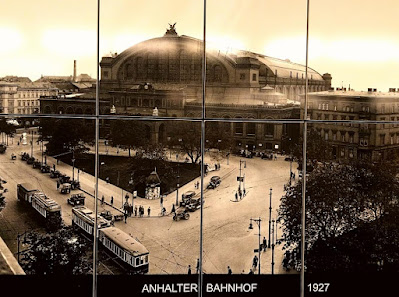The Anhalter Bahnhof
(Anhalt Station) was a mainline station in Kreuzberg, on the Askanischer
Platz, not far from Potsdamer Platz. The name « Anhalter »
derives from the Duchy of Anhalt, originally linked to Berlin by
trains leaving from this station.
The imposing building
was destroyed during WW II. It was the most important station for
travellers to Austria, Hungary, Italy, France, Greece.
Luxury trains from Compagnie Internationale des Wagons-Lits, like the
Riviera-Express, departed from the Anhalter Bahnhof, popularly known
as The Gateway to the South.
From 1928, the
station was connected to the nearby Hotel Excelsior by what was probably the
world’s longest hotel-tunnel (100 m), housing five
underground shops.
In the 1920s and
1930s, the Askanischer Platz was a meeting-place for the elegant
people of Berlin.
In
Erich Kästner’s novel Fabian, the hero gets into the station to
buy a newspaper. He then considers the possibility of buying a ticket
to pay a visit to his mother (who probably lived in Dresden), but
then decides to take a tram home.
After 1945, despite having been largely destroyed, the station was in service for some years, until it was replaced by the Zoo Station as main railway station of West Berlin, The Zoo Station, not built to be a terminal of main lines, was too small for its task, which didn't prevent it from remaining the gateway to West Berlin for decades, until the city's reunification in 1990. I remember a journey from West to East Berlin back in the 1970s, taking the local train there and disembarking at Friedrichsstrasse station, in the heart of the capital of the now defunct G.D.R.
After 1945, despite having been largely destroyed, the station was in service for some years, until it was replaced by the Zoo Station as main railway station of West Berlin, The Zoo Station, not built to be a terminal of main lines, was too small for its task, which didn't prevent it from remaining the gateway to West Berlin for decades, until the city's reunification in 1990. I remember a journey from West to East Berlin back in the 1970s, taking the local train there and disembarking at Friedrichsstrasse station, in the heart of the capital of the now defunct G.D.R.
 |
From
Walter Ruttmann's 1927 film, Berlin: Die Sinfonie der Großstadt
|
An excerpt from Eric D. Weitz' book Weimar Germany, promise and tragedy:
"The railway stations, authentic monuments to steel, iron and the dizzying progress of industrial society, constituted the glory of nineteenth-century architecture. Built between 1876 and 1880, the Anhalter station was among the best in Europe. Overhanging the buildings that surrounded it, its massive, imposing appearance, perfectly matched its task of sheltering the powerful steam engines of the railways from anywhere in Europe, which carried diplomats and statesmen to the Germany's capital. Its striking ornamentation of warped bricks and terracotta, the pale color of the sandstone used in some parts of the building and the semicircular arches, reminiscent of the Romanesque style, conferred some lightness on the building. Inside it, because it is worth it to make here a stop on our walk, the visitor will find not one but four waiting rooms, according to travelers and ticket classes. Trying to move from one to another was an almost impossible task. That will be the first obstacle we will discover. On the other hand, there were separate rooms for the authorities, for the exclusive use of dignitaries, including those who, before the revolution, had been appointed by the Hohenzollerns."
(my translation)
 |
| Foto: imago/Jürgen Ritter |




No comments:
Post a Comment